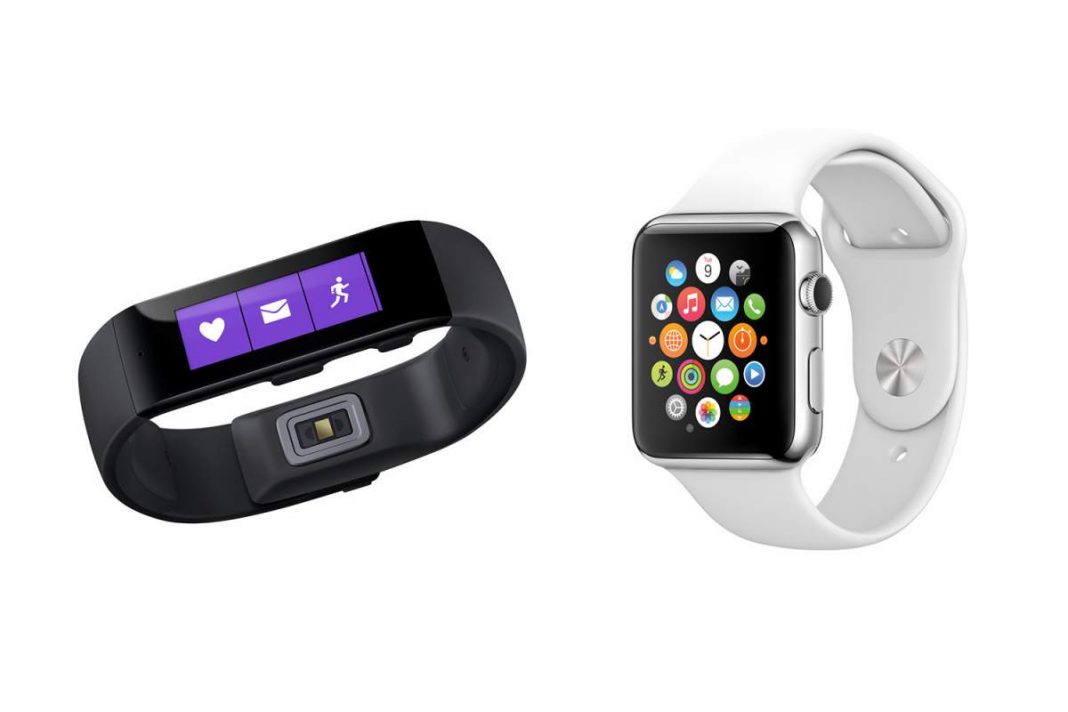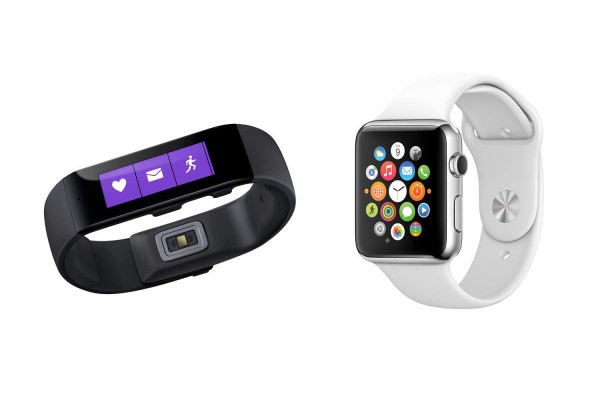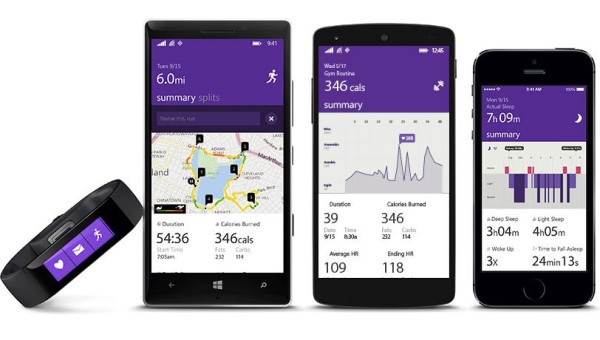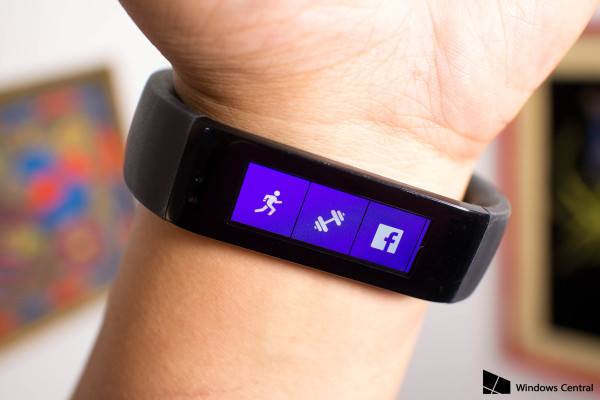
Microsoft has recently ramped up attempting to be a tech leader in the marketplace, and they seem to be aiming their arrow right at the monster tech company Apple. They’ve increased production along with their distribution apparatus for their Microsoft Band to beat the Apple Watch to the marketplace. With a much lower price, they’re chances are pretty good, but check out to see which one offers more bang for your buck below.
Microsoft is ramping up production and distribution of its Band smartwatch — capitalizing on the popularity of the device before Apple has shipped a single watch, the company announced Tuesday.
Production of the Microsoft Band, a $200 fitness wearable that also functions as a streamlined smartwatch, will be boosted as the device will now be sold at retailers Best Buy, Amazon.com and Target. Previously, the Band was available only at Microsoft’s stores and at Microsoft.com in limited quantities. The Band will also be sold in the United Kingdom along with the United States.
The aggressive expansion of the Band comes a month before the Apple Watch is expected to be shipped. And while consumers don’t appear to be excited about the Apple Watch, the Band has been an unexpected hit for Microsoft. Microsoft hasn’t disclosed sales numbers, but the product has been constantly out of stock in Microsoft Stores and available only for consumers who put their names on wait lists. Apple’s stock faltered after showing its watch last week.
In some ways, Apple is executing like the old and dominant Microsoft and Microsoft is executing as the resurgent Apple in the smartwatch race. The Microsoft Band is highly focused on core tasks and is understated — giving it performance advantages in key areas, namely battery life. The Band works with all major smartphone operating systems, including those running Apple’s iOS and Google’s Android in addition to Microsoft’s Windows. Meanwhile, the Apple Watch is attempting to be the technology jack-of-all-trades of smartwatches — making big trade-offs in exchange, namely battery life. And the Apple Watch is closed and proprietary — working only with Apple’s smartphones.
The Apple Watch is expected to last only 18 hours between charges, yet the Band can go roughly two days on a single charge. The Band can handle health and sleep tracking, such as heart rate monitoring, but has critical smartwatch functionality, including the ability to send and receive text messages, check stock prices and pay wirelessly at Starbucks. And the Band sells for $200, until the arrival of the Apple Watch, which will start at $350 for the lowest-end model.
It’s a major reversal in strategies. This time, it’s Microsoft that has announced a product, made it immediately available and then boosted production and availability. The ramp-up in distribution of the Band comes five months after Microsoft launched the wearable last October — beating the Apple Watch to market. The Apple Watch, shown months ago, won’t ship until April.
Microsoft Band vs Apple Watch comparison: design
Let’s start with the Microsoft Band. One look at the design tells you this is a fitness tracker rather than a smartwatch. It’s a plastic band with a big face, that comes in three sizes: small, medium and large (for wrists of 39mm, 41mm and 49mm). On those wrists you will be carrying around 60g, which is mostly made up of the 19 x 8.7mm main body of the device, which has on it two physical buttons. It is that size because of its capacitive 1.4in 320 x 106 display. This is impressive for an activity tracker/fitness band, although it pales into insignificance when placed next to Samsung‘s Gear S.
Our colleague Jon Phillips spent a few days with the Microsoft Band, and was less than impressed with the design: “Where the best wrist wearables are pliable and unobtrusive, the Microsoft Band is bulky and rigid, and never lets you forget you have it on. Sure, it’s physically large relative to competing fitness bands. But the bigger problem is its broad, inflexible display face. Factoring in the bezel around the display, it measures more than two inches long. It’s also straight as a board. A more comfortable chassis would follow the gentle curves of human anatomy.
“The upshot is the Microsoft Band never melts away into the background like a proper wearable. During testing, I always felt that something was on my wrist, especially when I banged the band on table tops, or got it caught on shirtsleeves. It’s omnipresent in the worst way possible.
“There’s nothing beautiful about the Microsoft Band clasp, which is what the world will see if you position the display on the underside of your wrist.
“The Microsoft Band is unique in that you can wear it on either wrist—all other wearables are designed for your non-dominant wrist. It can also be worn on the inside of your wrist. These options are nice, but I never found a comfortable position.
“In fact, the band felt most awkward—sort of like a handcuff—when I wore it on the inside of my dominant wrist. Every flex of my forearm reminded me that I was shackled to Microsoft’s ambitious new Health platform. This position also hides the Microsoft Band’s attractive 320×106 display, and instead shows the world its unglamorous clasping mechanism. Just look at the photo above. It looks like something designed by Raytheon, not a company interested in aesthetics.”
However, it is a well-built device, designed to stand up to life on an active wrist. It’s just neither beautiful nor particularly comfortable (in our tests, at least).
We haven’t had any hands-on time with the Apple Watch. No-one has! But we do know what Apple has told us. Expect a range of watch faces and six interchangeable straps. The Apple Watch is expected to be available in only two sizes: 38- and 42mm. Tough look for those with 49mm wrists – you best be going for the Microsoft Band. There are also three distinct collections: the Apple Watch collection has a polished silver or black case made from a custom alloy of stainless steel; the Apple Watch Sport collection has an anodised aluminium case in silver or space grey, with strengthened Ion-X glass and colourful, durable straps; and the AppleWatch Edition is made from 18-carat yellow or rose gold, which is twice as hard as standard gold, and has sapphire crystal glass, and equisitely crafted straps and closures.
We can safely expect the Apple Watch to be more beautiful than Microsoft’s less expensive Band. Going by Apple’s history it will also be more comfortable. Will it be as robust? We’ll have to wait and see until we can actually use one.
Microsoft Band vs Apple Watch comparison: features
Apple’s Watch is a customisable smartwatch designed to work with the iPhone 6 that is also a comprehensive health- and fitness device. It’s accurate to +/-50ms no matter where in the world you are, and allows you to connect and communicate directly from your wrist. A Digital Crown enables you to interact with the watch without obstructing the screen, and also operates as the home button. Siri is also supported, allowing for smart messages and dictation.
A flexible retina display is a single crystal of sapphire. Force Touch, tiny electrodes around the display, recognise the difference between a tap and a press, allowing for different gestures to be made. A linear actuator provides haptic feedback. This is the Apple Watch’s so-called Taptic Engine: more than just helpfully vibrating when you receive a new notification, it can do such things as provide slightly different vibrations for left- and right turns within the Maps app.
On the back a ceramic cover with sapphire lenses protects four sensors that make up the heart-rate monitor, which allows the Apple Watch to build up a comprehensive picture of your daily activities. The Apple Watch also has an accelerometer to measure body movement, and it uses the Wi-Fi and GPS in your iPhone to track distance. There’s a speaker, too, which is water-resistant.
A Glances feature lets you swipe up from the bottom of the screen to see whatever information you choose to have there. This is quick, at-a-glance summaries of such things as the weather forecast, your location or your calendar.
The Apple Watch lets you control music on your iPhone or computer, or music stored on the Watch itself. Any photos you favourite on your iPhone or Mac will also show up on your Apple Watch.
You can choose what types of notifications you receive on the Apple Watch, then simply raise your wrist to see the notification.
The Microsoft Band is powered by Microsoft’s new Health platform, which Windows Phone, Android and iOS users will be able to use even if they don’t own a Microsoft Band. Like Apple’s Health app, it collects and stores data from fitness devices (whether that’s the Microsoft Band or a third-party fitness tracker like the FitBit) to offer up insights to help you live a healthier life.
The Microsoft Band tracks your heart rate, steps, calories and sleep, and feeds all of that information into the Health app. You can set goals, use the Microsoft Band to complete guided workouts, map the routes you’ve run, cycled or hiked using GPS, and more.
In addition to the fitness features, you’ll also be able to connect your Microsoft Band to your smartphone or tablet via Bluetooth to get notifications such as emails, calendar alerts and text messages, which you’ll be able to preview. It’ll also let you know when you’ve got an incoming phone call, if you’ve got a notification from Twitter or Facebook, for example.
There’s a built-in timer and alarm app on the Microsoft Band, too.
For Windows Phone 8.1 users, the Microsoft Band gives you access to Cortana from your wrist. You can ask Cortana to take a note for you, or set a reminder, for example. Microsoft has also partnered up with third-parties to bring more compatible apps to the Microsoft Band, including Starbucks, MyfFitnesspPal, RunKeeper and more.
Without knowing more about the Apple Watch, and certainly without playing with one, it is hard to be definitive about the differences here. Expect the Apple Watch to be more sophisticated than the Microsoft Band. Certainly expect it to offer a greater feature set, and better integration with iPhones. Whether that makes it a better device for you only time – and your opinion – will tell.
Microsoft Band vs Apple Watch comparison: specs
The Microsoft Band runs off an ARM Cortex M4 MCU CPU. You get only 64MB onboard storage, so using a smartphone is required for smartphone-like functions: but at least the Microsoft Band synchs with all smartphones via Bluetooth 4.0. GPS is built in so you can work out without your phone being present. so there’s no need to carry your smartphone around with you in order to accurately record and map your runs. You get a three-axis accelerometer, and a gyrometer. Odd inclusions are an ambient light sensor and a skin temperature sensor. Oh, and there’s a UV monitor similar to that of the Galaxy Note 4. And there is an optical heart sensor so you can monitor your heart-rate 24 hours a day. (In our testing this was far from accurate.)
I don’t know if these are things you want to track, but if you do the requisite sensors are onboard.
We know less about the Apple Watch. There are four sensors on the back, these include a heart rate and a gyroscope that can be used to track activity. A custom-designed S1 chip powers the Apple Watch. And that’s about all we know. We’ll keep you posted!
Microsoft Band vs Apple Watch comparison: battery life
This may be a killer feature for one or both of these devices – in the sense that poor battery life will kill them off. The Microsoft Band has a dual 100mAh rechargeable lithium-ion polymer battery, which Microsoft claims will last for two days. In our tests we got comfortably more than a day’s use, and that was hammering the GPS and the screen’s brightness (to be fair to Microsoft its two-day claim comes with the proviso that excessive use of GPS will eat into this).
Apple made no mention of battery life during the Apple Watch announcement. But speaking to Re/code, Apple spokeswoman Nat Kerris confirm that users should get used to a nightly charge.
“We anticipate that people will charge nightly which is why we designed an innovative charging solution that combines our MagSafe technology and inductive charging,” Kerris said. This is a pretty liberal use of the word ‘innovative’, as multiple Android Wear smartwatches engage this system. But we commend the nightstand charger approach as it should disrupt the average watch-wearer’s experience.
Microsoft Band vs Apple Watch comparison: verdict
Without knowing more about the Apple Watch we can give no definitive verdict, of course. But a few things are clear. The Microsoft Band is far from perfect, but it is a super-powered activity tracker that offers some smartwatch capabilities. It is well priced, and flexible. The Apple Watch will be considerably more expensive, but should at least offer many more functions and features. And it will tie you to using only a recent iPhone, unlike the Microsoft Band. So buy a cheaper, more flexible but less functional product now, or wait and see what Apple can come up with. The choice is yours.




